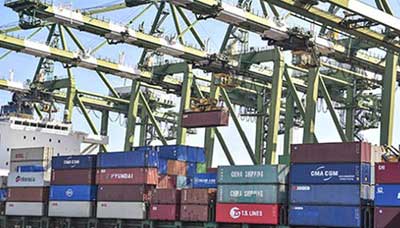Relevance: GS-3: Infrastructure: Ports;
Key Phrases: Transhipment hub, twenty-foot equivalent units.
Context
- Every year, India loses revenue on a quarter of its own container
cargo.
- And in addition to this, it is unable to capitalise on cargo bound for other countries.
- Much of this loss is of ports on the eastern coast. The loss is primarily because India does not have a transhipment hub of its own around the southern tip.
What are Transhipment hubs?
- Transhipment refers to the movement of a container or cargo from one vessel (feeder's vessel) to another (mainline vessel) while in transit to its final destination.
- It involves the process of:
- Consolidation - where smaller packages, from different sources, are grouped together to be sent off to a final destination.
- Deconsolidation - where bigger packages, from different sources, are degrouped to be sent off to their final destination.
Status of Cargo Handling in India
- Cargo handled at ports can be measured in twenty-foot equivalent units (TEUs).
- In 2019, Indian ports handled around 16 million TEUs of container
traffic.
- 75% of these were gateway containers (which operate directly from the port of origin to the port of destination), while
- 25% were transhipment containers (4 million TEUs).
- About 3.5 million TEUs were transhipped at ports outside India.
- These were handled by
- Colombo - which handled 2-2.5 million TEUs of Indian containers
- Singapore and
- Klang in Malaysia
- These were handled by
Reasons behind such loss and status quo
- Unavailability of mainline vessels calling at these ports.
- Due to this India suffers a loss of transhipment.
- Despite the better location of the west coast of India, most of the
container ports are gateway ports,
- These send cargo containers directly to destinations.
- Mere 8% of the total container traffic from the major ports on the west coast is transshipped.
- The east coast loses transshipped container cargo to international
ports.
- During the past three years, data show that as much as
- 62-67% of total container traffic from major ports on the east coast was transhipped.
- Most of the east coast ports, such as Kolkata, Haldia, Vizag and VO Chidambaranar, are losing mainline/direct traffic to Colombo.
- During the past three years, data show that as much as
Repercussions of not having transhipment ports
- Revenue loss is enormous.
- India is losing ₹1,200 crores per year of potential forex
benefit to Sri Lanka,
- With an assumption of a loss of ₹ 6000 per container.
- Loss of income from vessel-related charges and employing direct and indirect manpower.
- India is losing ₹1,200 crores per year of potential forex
benefit to Sri Lanka,
- Rising logistics costs.
- Decreased cost-competitiveness of exports.
- Depriving India of capitalising on its strategic location in the Indian
Ocean
- Of handling its own cargo.
- Handling the traffic on the circuit on which India falls.
Case for transhipment hub
- The key parameters of draft availability and deviation from the main international Suez-Far East maritime trade route, are to be weighed upon to decide where transhipment ports should be developed.
Draft availability and deviation from conventional routes
| Draft Potential | Maritime Route Deviation | |
| VO Chidambaranar | 18 meters | 6-8 hours |
| Cochin | 16 meters | 4-6 hours |
| Vizhinjam | 20 meters | 0.5-1 hours |
Tariff Charges
- Container freight is a consolidated tariff charged by the
mainline vessel operators.
- Hence, this must be a cheaper port. (as the charges are construed as intermediary charges)
- If the transhipment facility is available at Tuticorin and Vizhinjam, it is equally beneficial to halt at these locations as at Colombo.
Hence, the Vizhinjam and VO Chidambaranar ports have the potential for developing as transhipment hub ports.
Key steps involved
- To attract an anchor shipping line.
- The Vizhinjam and VO Chidambaranar ports meet the shipping lines’ key selection parameters: proximity to the mainline maritime route and deep-draft availability.
- This can ensure their viability in the longer run.
- Discounting or reduction in tariff due to recent reforms
- The Major Port Authorities Act, 2021, and the new model concession agreement give private operators at the major ports flexibility to charge market-driven tariffs.
- Lower vessel-related tariffs
- Availability of adequate parcel size as easy availability of hinterland apart from these two ports stretch to the entire east coast of India, along with parts of the west coast.
- Governance framework for productive port operations (IT-enabled
systems for Customs and taxation)
- ICEGATE and SWIFT have been introduced.
- Mechanisation and automation level at berths,
- For faster turnaround time.
- Easy and efficient handling storage,
- Faster evacuation through excellent road/rail connectivity.
- Better forward and backward linkages.
- Ancillary services, such as bunkering, crew change, international airport and hotels must be set up.
Setting up a transhipment hub in line with the national objective of PM Gati Shakti-National Master Plan has become an urgent imperative.
Benefits
- First up, reduced logistics for shippers,
- For the immediate hinterland of transhipment port, 12-15% savings on total freight cost).
- On domestic/coastal routes (4-5% savings on the total freight cost).
- It will boost higher container coastal traffic.
- It will ensure greater integration with world trade, - leading to more lines calling the country and also opening direct access to the developed markets.
- There would be a significant increase in efficiency and throughput, leading to keener competition from other ports in the country.
Source: The Hindu BL
Mains Question
Q. Explain the concept of Transhipment hubs.How can it help India to increase Logistics Efficiency?







